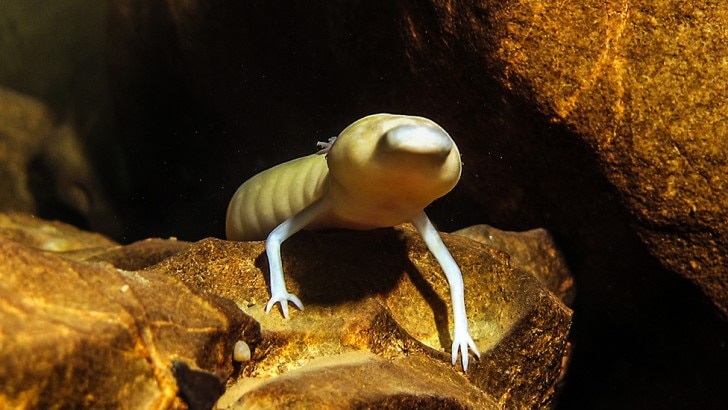BBC Earth newsletter
BBC Earth delivered direct to your inbox
Sign up to receive news, updates and exclusives from BBC Earth and related content from BBC Studios by email.
Seven Worlds, One Planet
Here be dragons! Sort of…
If you think of Europe and dragons, you’re likely to imagine the Welsh flag, St George, or one of the many stone beasts adorning the continent’s castles, bridges or town squares. But we all know real dragons aren’t so accustomed to a public life and Europe’s real dragon prefer a mysterious, subterranean world, deep within a labyrinth of caves.
Olms are tiny blind salamanders found in the cave networks of Bosnia and Herzegovina, Croatia, Italy, Slovenia and France. Their distinctive features are what gives them their range of names. Due to their snake-like bodies and frilly gills, medieval legend believed them to be baby dragons. They are also called the damp creepy-crawly (močeril) and the ‘human-fish’ (čovječja ribica), as they also look like a hybrid of those two species. The reason for this is that their skin is translucent, with no pigment, giving them the appearance of ghostly human flesh. In fact, if you look at their abdomens, you can see their internal organs!

The body of an olm is perfectly adapted to its environment of pitch-black darkness. Adult olms are completely blind with underdeveloped eyes covered by a layer of skin. However, olm larvae have normal eyes for the first four months of their life before they start to regress. They have to therefore rely on other ‘super senses’ and their heads are equipped with chemo, mechano and electroreceptors. These help them detect chemical substances, pressure and weak electrical fields in water respectively.
The prey that olm uses these powers to hunt include insect larvae, small crabs and snails. They can eat large volumes of food in a single sitting and are able to store vital reserves of nutrients in their liver for periods of scarcity. By reducing their metabolic activity and reabsorbing their own tissues, experiments show that olms can survive without food for up to 10 years. An astonishing fact, made even more interesting by the fact that olms can live up to 100 years old.

Olms are incredibly social creatures, with the sole exception of sexually active males, who withdraw from the group, and become solitary and territorial. In this newly acquired area, they secrete a pheromone to attract mates. If they successfully pair, the female will then go off to lay between 5-70 eggs elsewhere, where she’ll watch over them. Unlike most other amphibians, olm larvae don’t metamorphosis. Instead, the larvae develop directly into adults around 4 months of age. Olms reach sexual maturity at the age of 10-15 years and can mate all year round.
Water is central to olm life. They eat, sleep and breed underwater. As such, olms require clean water and they are vulnerable to changes to water quality and temperature. Fortunately for them, they have lived in a constant environment for 200 million years. Unfortunately, those conditions are starting to change.
Water pollution and habitat change are the main reasons that the olm population is declining. Dirty and contaminated water, from sources ranging from construction to agricultural, seeps down into the cave systems, changing the composition of the olm’s home waters. Tragically, as the olm population decreases, their value to collectors increases. The threat from black market collectors grows.
The race is on to better understand the olm in order to protect them. In France, scientists have been studying captive olms in underground laboratories since the 1950s to try and understand the biological mechanisms of adaptation of these species to their environment, unchanged for millions of years.

The Seven Worlds, One Planet production team worked with biologists in Slovenia at the famous Postojna Cave system where there is an ongoing research and captive breeding programme. In 2013 scientists here witnessed for the first time a female laying eggs in captivity and were able to document the development of the embryos.
A long-term conversation project is also underway in Croatia to protect the subterranean cave habitats that are home to the olm. It aims to develop a conservation research plan for the olm in Croatia with objectives of developing a pioneering technique for assessing olm population genetics, enhancing public awareness of the species and conducting population studies at three sites which will contribute to the National Management and Action Plan.
Featured image © BBC NHU